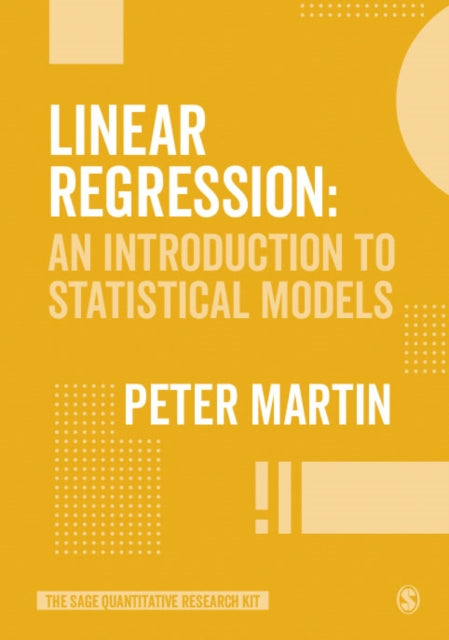Peter Martin
Linear Regression: An Introduction to Statistical Models
Linear Regression: An Introduction to Statistical Models
YOU SAVE £1.63
- Condition: Brand new
- UK Delivery times: Usually arrives within 2 - 3 working days
- UK Shipping: Fee starts at £2.39. Subject to product weight & dimension
Bulk ordering. Want 15 or more copies? Get a personalised quote and bigger discounts. Learn more about bulk orders.
Couldn't load pickup availability
- More about Linear Regression: An Introduction to Statistical Models
This text provides an introduction to fundamental linear regression models used in quantitative research, covering theory, application, and model selection with guidance on checking assumptions and avoiding overfitting. It is part of The SAGE Quantitative Research Kit.
Format: Paperback / softback
Length: 200 pages
Publication date: 21 March 2022
Publisher: SAGE Publications Ltd
This comprehensive text delves into the realm of fundamental linear regression models, serving as a valuable resource for quantitative research. It encompasses both the theoretical underpinnings and practical applications of these statistical frameworks, providing readers with a clear understanding of their usage. Through illustrative graphs, the author effectively demonstrates the concepts and methodologies involved in linear regression analysis. Furthermore, the author offers insightful guidance on crucial aspects such as selecting the most suitable model for specific research objectives, conducting simple and multiple linear regressions, assessing model assumptions, and mitigating the risks of overfitting. This book is an essential component of The SAGE Quantitative Research Kit, empowering readers to navigate the complexities of multivariate analysis of social science data with confidence and proficiency.
Linear regression is a statistical method used to analyze the relationship between a dependent variable and one or more independent variables. It is a widely used technique in quantitative research, particularly in social sciences, where researchers aim to understand the relationship between variables and predict outcomes.
There are several types of linear regression models, each with its own advantages and limitations. The most common models include:
Simple Linear Regression: Simple linear regression is a basic model that assumes a linear relationship between the dependent variable and the independent variables. It uses a straight line to represent the relationship between the variables and calculates the slope and intercept of the line.
Multiple Linear Regression: Multiple linear regression extends simple linear regression by including multiple independent variables in the model. It allows for the analysis of the interaction between variables and the prediction of outcomes based on a combination of variables.
Polynomial Regression: Polynomial regression is used when the relationship between the dependent variable and the independent variables is non-linear. It allows for the inclusion of higher-order terms in the model to capture complex relationships.
Logistic Regression: Logistic regression is used when the dependent variable is categorical (e.g., binary, ordinal, or nominal). It uses a logistic function to model the relationship between the dependent variable and the independent variables and predicts the probability of a certain outcome.
Regression analysis involves several steps, including:
Defining the research question and identifying the dependent and independent variables.
Collecting data and ensuring its quality and relevance.
Cleaning the data to remove any missing values, outliers, or inconsistencies.
Selecting the appropriate regression model based on the nature of the data and the research question.
Estimating the model parameters using statistical methods such as least squares regression.
Assessing the model's performance using statistical measures such as R-squared, adjusted R-squared, and p-values.
Interpreting the results and making meaningful conclusions.
Linear regression models have numerous applications in social sciences, including:
Predicting the outcome of a dependent variable based on the values of independent variables.
Exploring the relationship between variables and identifying factors that influence outcomes.
Predicting the probability of a certain outcome (e.g., the probability of a person being diagnosed with a disease).
Understanding the relationship between variables and their impact on social phenomena.
However, it is important to note that linear regression models have limitations. They assume a linear relationship between the variables and may not be appropriate for complex relationships or non-linear data. Additionally, overfitting the model can lead to poor predictions and inaccurate conclusions.
To address these limitations, researchers can use various techniques such as cross-validation, regularization, and model selection methods to improve the accuracy and reliability of linear regression models. They can also explore alternative statistical models such as nonlinear regression, Bayesian regression, or machine learning algorithms that are better suited for complex data and non-linear relationships.
In conclusion, linear regression is a powerful statistical method used to analyze the relationship between variables and predict outcomes. It has numerous applications in social sciences, but it is important to use the model appropriately and consider its limitations. By using appropriate techniques and exploring alternative models, researchers can improve the accuracy and reliability of their linear regression models and make meaningful contributions to social science research.
Weight: 364g
Dimension: 169 x 241 x 17 (mm)
ISBN-13: 9781526424174
This item can be found in:
UK and International shipping information
UK and International shipping information
UK Delivery and returns information:
- Delivery within 2 - 3 days when ordering in the UK.
- Shipping fee for UK customers from £2.39. Fully tracked shipping service available.
- Returns policy: Return within 30 days of receipt for full refund.
International deliveries:
Shulph Ink now ships to Australia, Belgium, Canada, France, Germany, Ireland, Italy, India, Luxembourg Saudi Arabia, Singapore, Spain, Netherlands, New Zealand, United Arab Emirates, United States of America.
- Delivery times: within 5 - 10 days for international orders.
- Shipping fee: charges vary for overseas orders. Only tracked services are available for most international orders. Some countries have untracked shipping options.
- Customs charges: If ordering to addresses outside the United Kingdom, you may or may not incur additional customs and duties fees during local delivery.


